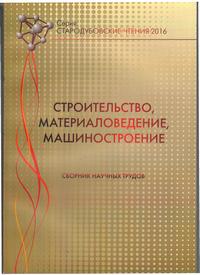Porosity factors of fired brick based on technogenic raw materials
Keywords:
Porosity, Fired Brick, Loam, Wastes, Mineral Raw Materials, Safe PoresAbstract
Purpose. To obtain optimum porosity of fired brick through the modification with technogenic mineral systems. . Methodology. A study of micro- and macroporosity was carried out in Germany through the use of a mercury porosimeter Pascal 140 and 440 Protec. Findings. Studies established that for obtaining a composition based on loam, ferrous wastes, AND sludge from
the Central Aeration Station (CAS) safe porosity is 50,18 % of total porosity. For fired brick based on wastes from Volnogorsk Mining and Metallurgical Combine (VMMC), sludge from the CAS and ferrous wastes porosity is 78,11 %. Originality. It has been found that an increase in the content of better CAS sludge causes a decrease in the number of safe pores. For a ternary composition based on loam, sludge and ferrous wastes total porosity is 30 %. Complete substitution of loam with VMMC wastes, CAS sludge and ferrous wastes leads to a better safe porosity compared to a composition based on loamy raw materials. At reducing sludge content, i.e. increasing VMMC waste percentage safe porosity increases. Total porosity of a sample fired at a temperature of 850 о С is 25,61 %. Practical value. Based on the conducted fired brick tests results, 100 and 200 grade bricks with frost resistance of 25 and 35 cycles have been obtained.
References
Derevianko V.M., Hryshko H.M. Zavisimost temperaturyi obzhiga suglinka ot soderzhaniya organo- i schelochezhelezosoderzhaschih sistem [Dependence of Loam Firing Temperature on the Composition of Systems Containing Alkali And Organic Systems]. VIsnik OdeskoYi derzhavnoYi akademIYi budIvnitstva ta arhItekturi. [Bulletin of the Odessa State Academy of Civil Engineering and Architecture]. 2015, Issue No. 58, pp. 71– 78. (in Ukrainian).
Prikhodko A.P., Stotrchai N.S., Hryshko H.M., Vecher Yu.N. Poluchenie keramicheskih materialov na osnove tehnogennogo syirya [Production of Ceramic Materials Based on Technogenic Materials]. Noveyshie dostizheniya v oblasti importozameschenie v himicheskoy promyishlennosti i proizvodstve stroitelnyih materialov: materialyi mezhdunarodnoy nauchno-tehnicheskoy konferentsii – [Latest Achievements in Import Substitution in the Chemical Industry and in the Manufacture of Building Materials: International Scientific and Technical Conference information package]. Minsk, 2012, Ch. 1, pp. 64-68.
Abdrakhimova Ye.S. Vliyanie fazovogo sostava na morozostoykost keramicheskogo kirpicha [Effect of the Phase Composition on the Frost Resistance of Ceramic Bricks]. Izvestiya vuzov. Stroitelstvo. [Izvestiya Vuzov. Construction]. 2008, no. 4, pp. 28-30. (in Russian).
Budnikov P.P., Balkevich V.L., Berezhnoy A.S., etc. Himicheskaya tehnologiya keramiki i ogneuporov. [Chemical Technology of Ceramics and Refractories]. M. : Publishing House of Literature on Construction, 1972, 551 p.
Deer W.A., Howie R.A., Zussman J. Porodoobrazuyuschie mineralyi v 5 tomah. [Rock Forming Minerals in 5 Volumes]. M. :Mir, 1965, 1960 p.
Naumov A.A., Yundin A.N. Uvelichenie morozostoykosti kirpicha polusuhogo pressovaniya mineralnoy modifitsiruyuschey dobavki. [Improvement of Frost Resistance of Semidry Pressed Bricks with a Mineral Modifying Additive]. Izvestiya vuzov. Stroitelstvo. [Izvestiya Vuzov. Construction]. 2011, no 8-9, pp. 27-31. (in Russian).
Burmistrov V.N., Vedernikov G.V. Povyishenie effektivnosti proizvodstva keramicheskogo kirpicha. Dostizheniya stroitelnogo materialovedeniya. [Improving Fired Brick Production Efficiency. Achievements of Construction Materials Science]. Sb. nauch. st., posvyaschennyiy 100-letiyu so dnya rozhdeniya P. I. Bozhenova. [Collection of Scientific Articles Dedicated to the 100th Anniversary of P.I. Bozhenov’s Birth]. SPb. Izd-vo OM-Press, 2004. pp. 140. (in Russian).
Zubekhin A.P., Dovzhenko I.G. Povyishenie kachestva keramicheskogo kirpicha s primeneniem osnovnyih staleplavnyih shlakov.[Improving Fired Brick Quality by Use of Basic Steelmaking Slags]. Stroitelnyie materialyi. [Construction Materials]. 2011, no 4, pp. 57-59. (in Russian).
Zubekhin A.P., Golovanova S.P., Yatsenko N.D., etc. Spektroskopicheskie i kristallohimicheskie osnovyi beliznyi i tsvetnosti silikatnyih materialov. [Spectroscopic and Crystallochemical Bases of Silicate Materials Whiteness and Color Value]. Izvestiya Vuzov. Sev.-Kavk. region. tehn. nauki. [Izvestiya Vuzov. North Cauc. Region. Tech. Science]. 2007, no 5, pp. 40–43. (in Russian).
Abdrakhimov V.Z., Abdrakhimova Ye.S., Dolgiy Ye.P. Vliyanie zhelezosoderzhaschego shlaka na strukturu poristosti keramicheskogo kirpicha. [Effect of Ferrous Slag on Fired Brick Porosity Structure]. Izvestiya vuzov. Stroitelstvo. [Izvestiya Vuzov. Construction]. 2006, no 1, pp. 36-39. (in Russian).
Stolboushkin A.Yu., Ivanov A.I., Storozhenko G.I., Urazov S.I. Poluchenie morozostoykogo keramicheskogo kirpicha polusuhogo pressovaniya iz promyishlennyih othodov. [Production of Frost Resistant Semidry Pressed Bricks from Industrial Waste]. Stroitelnyie materialyi. [Construction Materials]. 2011, no 12, pp. 4-7. (in Russian). Статья рекомендована к публикации д-ром техн. наук, В.И. Большаковым и д-ром техн. наук, Д.В. Лаухиным (Украина)
Downloads
Published
Issue
Section
License
Редакція Видання категорично засуджує прояви плагіату в статтях та вживає всіх можливих заходів для його недопущення. Плагіат розглядається як форма порушення авторських прав і наукової етики.
При виявлені у статті більш ніж 25% запозиченого тексту без відповідних посилань та використання лапок, стаття кваліфікується як така, що містить плагіат. У цьому випадку стаття більше не розглядається редакцією, а автор отримує перше попередження.
Автори, в статтях яких повторно виявлено плагіат, не зможуть публікуватися в усіх журналах Видавництва ДВНЗ «Придніпровська державна академія будівництва та архітектури».
Автори, які публікуються у цьому журналі, погоджуються з наступними умовами:
- Автори залишають за собою право на авторство своєї роботи та передають журналу право першої публікації цієї роботи на умовах ліцензії Creative Commons Attribution License, котра дозволяє іншим особам вільно розповсюджувати опубліковану роботу з обов'язковим посиланням на авторів оригінальної роботи та першу публікацію роботи у цьому журналі.
- Автори мають право укладати самостійні додаткові угоди щодо неексклюзивного розповсюдження роботи у тому вигляді, в якому вона була опублікована цим журналом (наприклад, розміщувати роботу в електронному сховищі установи або публікувати у складі монографії), за умови збереження посилання на першу публікацію роботи у цьому журналі.
- Політика журналу дозволяє і заохочує розміщення авторами в мережі Інтернет (наприклад, у сховищах установ або на особистих веб-сайтах) рукопису роботи, як до подання цього рукопису до редакції, так і під час його редакційного опрацювання, оскільки це сприяє виникненню продуктивної наукової дискусії та позитивно позначається на оперативності та динаміці цитування опублікованої роботи (див. The Effect of Open Access).

